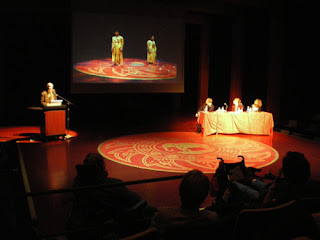Yesterday, we were privileged to host an extraordinary group of scholars and artists at a symposium that responded to the themes and histories addressed in Philip Kan Gotanda’s new play, I Dream of Chang and Eng. This play received its nonprofessional premiere here at UC-Berkeley, a story that is itself a tale about the role that a university as a laboratory for new artistic work, as well as the role that the arts can play in disseminating the intellectual life of the campus to a wider public.
Leaving aside those large and luminous goals for other postings, let me take a moment to thank our co-coordinators and co-sponsors as well as the incredible speakers we were privileged to hear. Because this play addresses the complex and exceptional history of the conjoined brothers who would become known as the Siamese twins—a development that would oddly enough give this nationalist marking (Siam) to the physical experience of conjoined bodies, we worked with an array of scholars in the fields of disability studies, Asian studies, and American popular culture to think together about the twins as a social phenomenon. Cynthia Wu, Ellen Samuels and Lena each in their own way are experts on the social fascination cultures have had with conjoinment, sharing reflections on the legacies of Chang and Eng Bunker with equal attention to their racial status. Indeed, whether or not Chang and Eng can be retroactively understood as “Asian American” was an intriguing question, especially because they arrived in the United States early in the 1800s, before Asian immigrants had a designated legal status or a recognized identity category. Throughout the day, too, we discussed how conjoinment was figured by the 19th century freak show (in Barnum’s circus, in World’s Fairs, and in other popular performances) and how it is figured now by a contemporary discourse of disability rights, one that is not only critical of the de-humanizing frames placed on conjoinment but also of the sentimental conventions that structure the reception of disability now. Eric Hayot, Sam Otter, and Amma Ghartey-Targoe gave us a window into large histories of literary imagining, of Western projections of Asian difference, and of the politics of racial display that activated the most popular entertainments of the 19th century. Meanwhile, dramaturge Shannon Steen, director Peter Glazer, and Philip Kan Gotanda himself closed out the symposium with poignant reflection upon how these fraught histories dynamized the experience of writing and rehearsing the play. We estimate around 150 students, faculty, and Bay Area citizens gathered with us for six hours of exploration and debate, followed by a lovely reception and the show itself.
Leaving aside those large and luminous goals for other postings, let me take a moment to thank our co-coordinators and co-sponsors as well as the incredible speakers we were privileged to hear. Because this play addresses the complex and exceptional history of the conjoined brothers who would become known as the Siamese twins—a development that would oddly enough give this nationalist marking (Siam) to the physical experience of conjoined bodies, we worked with an array of scholars in the fields of disability studies, Asian studies, and American popular culture to think together about the twins as a social phenomenon. Cynthia Wu, Ellen Samuels and Lena each in their own way are experts on the social fascination cultures have had with conjoinment, sharing reflections on the legacies of Chang and Eng Bunker with equal attention to their racial status. Indeed, whether or not Chang and Eng can be retroactively understood as “Asian American” was an intriguing question, especially because they arrived in the United States early in the 1800s, before Asian immigrants had a designated legal status or a recognized identity category. Throughout the day, too, we discussed how conjoinment was figured by the 19th century freak show (in Barnum’s circus, in World’s Fairs, and in other popular performances) and how it is figured now by a contemporary discourse of disability rights, one that is not only critical of the de-humanizing frames placed on conjoinment but also of the sentimental conventions that structure the reception of disability now. Eric Hayot, Sam Otter, and Amma Ghartey-Targoe gave us a window into large histories of literary imagining, of Western projections of Asian difference, and of the politics of racial display that activated the most popular entertainments of the 19th century. Meanwhile, dramaturge Shannon Steen, director Peter Glazer, and Philip Kan Gotanda himself closed out the symposium with poignant reflection upon how these fraught histories dynamized the experience of writing and rehearsing the play. We estimate around 150 students, faculty, and Bay Area citizens gathered with us for six hours of exploration and debate, followed by a lovely reception and the show itself.
The day would not have been possible without the incredible creativity of one of my home department, Theater, Dance and Performance Studies, without or co-coordinator Susan Schweik who runs our Disability program at UC-Berkeley. Other sponsors—the Center for Chinese Studies, the English department, the Center for Race and Gender, and the East Asian Languages and Cultures department—made sure we had the funds to fly out our guests and feed all who attended. Finally, our incredible ARC staff—Michele Rabkin, Laura Paulini, Juan David Rangel—attended to every detail and made sure that we pulled off a truly celebratory event.

No comments:
Post a Comment